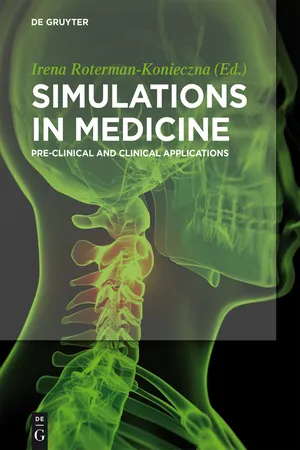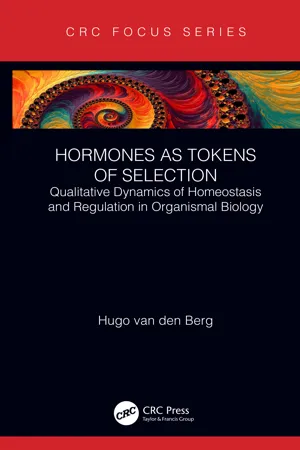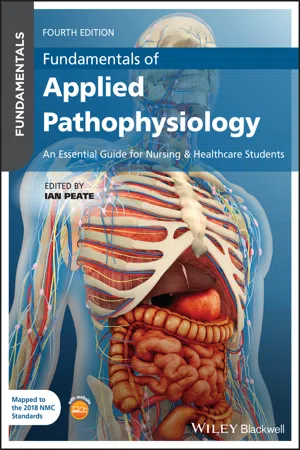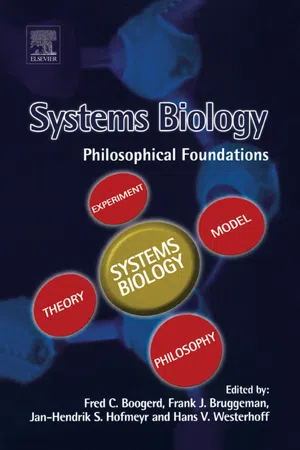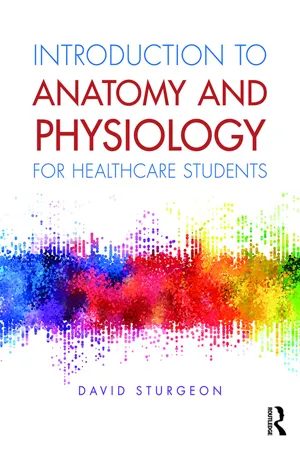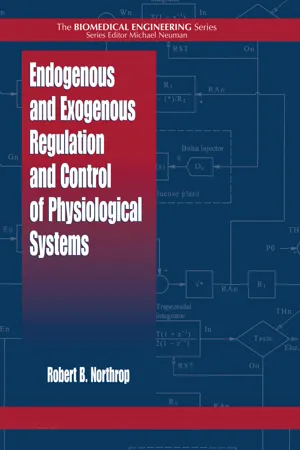Biological Sciences
Feedback Mechanisms
Feedback mechanisms are processes in living organisms that maintain homeostasis by regulating internal conditions. They involve the detection of a change in a physiological parameter, a response to counteract the change, and a signal to indicate whether the change has been reversed. These mechanisms are essential for the stability and proper functioning of biological systems.
Written by Perlego with AI-assistance
Related key terms
6 Key excerpts on "Feedback Mechanisms"
- eBook - ePub
- Irena Roterman-Konieczna, Irena Roterman-Konieczna(Authors)
- 2015(Publication Date)
- De Gruyter(Publisher)
Cellular levelPassage contains an image Jakub Wach, Marian Bubak, Piotr Nowakowski, Irena Roterman, Leszek Konieczny, and Katarzyna Chtopas
2 Negative feedback inhibition – Fundamental biological regulation in cells and organisms
The functioning of biological systems is governed by the laws of physics and chemistry. Biological processes occur spontaneously and are subjected to thermodynamic regulation.Thermodynamics introduces a distinction between open and closed systems. Reversible processes occurring in closed systems tend to a state of equilibrium. This state is achieved when the reaction proceeds at an identical rate in both directions (from substrate to product and from product to substrate) – a situation which can be denoted v 1 = v 2 . In terms of energy transfer this state is inert, with nil spontaneity (ΔG = 0) (Fig. 2.1(a) ). In thermodynamically open systems (including all biological systems) equilibrium is not achieved spontaneously – it can, however, be maintained by continually replenishing the required substrates. This so-called stationary state is characterized by nonzero spontaneity ΔG ≠ 0) (Fig. 2.1 (b) ).Maintaining a stationary state requires regulation. In nonsentient systems, such as the interior of a cell, regulation must be automatic and is typically based on negative feedback loops, as shown in Fig. 2.2 .The negative feedback loop may be symbolically represented as a closed circuit in which a detector monitors the state of a controlled process while an effector counteracts detected changes. The function of the effector is dependent on signals received from the detector (see Fig. 2.2 ).In cells and organisms detectors are usually referred to as “receptors”. Most receptors are proteins which react with the products of a controlled process. Their genetically-conditioned affinity to a specific product enables them to control its concentration. Such structures can be found inside the cell, as well as in the cellular membrane, with receptors protruding into the environment and capable of registering external signals (Fig. 2.3 (a) , (b) and (c) - eBook - ePub
Hormones as Tokens of Selection
Qualitative Dynamics of Homeostasis and Regulation in Organismal Biology
- Hugo van den Berg(Author)
- 2019(Publication Date)
- CRC Press(Publisher)
Chapter 2The nature of homeostasisHomeostasis refers to the tendency to maintain a constant or near-constant internal environment for the biochemical and physiological processes of life [102 ]. Familiar examples at the cellular level include the cytosolic concentrations of chemical species that affect the rates of metabolism (e.g. [H3 O+ ], [ATP], the intermediates of the Krebs† cycle) and at the organismal level physico-chemical parameters of interstitial fluids and blood, such as temperature, pressure, oxygenation, nutrient concentrations [78 ]. By maintaining such variables at constant or near-constant values, the body creates a stable and predictable milieu intérieur providing steady operating conditions for the processes of life, even when the organism’s ambient environment, the milieu extérieur , undergoes marked fluctuations or is severely perturbed.At the heart of homeostasis lies the principle of feedback control , also known as closed loop control. Life scientists perhaps shy away from the term ‘control’ to avoid unintended teleological imputations and may prefer to speak of regulation ; however, the hallmark of regulation is the use of feedback to attain what engineers unabashedly call ‘desired behaviour’ [64 ]. In a biological context, ‘desirable’ has to be understood as a shorthand for ‘conferring adaptive value,’ as we will argue in Section 2.1 . Moreover, the biological context requires a slightly different mathematical formalism than the classic engineering context, because coarse-graining and time-scale arguments are essential for tractable models of complex biological systems [11 ]. The basic notions and notations used in the chapters that follow are introduced in Section 2.2 .2.1The Origins of HomeostasisInformation science in its broadest meaning presents itself as the medium of choice for the study of biological regulation. Control and homeostasis find a natural fit in what used to be called cybernetics , the theory and craft of process control (from κυβερνητική, the art of the maritime pilot). However, there are differences in outlook and parlance which engender unnecessary confusion and debate. For instance, control engineers call the value that is maintained the ‘reference value,’ or ‘desired value,’ or ‘set-point’ [39 ], terms which may worry the biologist, since the system operates without conscious desires or goal-orientation [38 ].‡ - eBook - ePub
Fundamentals of Applied Pathophysiology
An Essential Guide for Nursing and Healthcare Students
- Ian Peate, Ian Peate(Authors)
- 2021(Publication Date)
- Wiley-Blackwell(Publisher)
Figure 3.2 ). Receptors restore optimum levels, for example:- Core body temperature
- Blood glucose levels
- Electrolyte and water concentrations
- pH of body fluids
- Blood and tissues oxygen and carbon dioxide levels
- Blood pressure.
Set points
As the internal and external environments of the body are continually changing, adjustments have to be made constantly to stay at or near a specific value; this is the set point.Whilst it accepted that there are normal fluctuations from the set point, the body’s systems will usually attempt to revert to this point. If the body becomes too warm, for example, alterations are made to cool the individual. If blood glucose levels increase after a meal, then adjustments are made to lower those levels. When adjustments to the set point are needed, the feedback loop works to maintain the new setting. There are two types of feedback: negative and positive.Negative feedback
Nearly all physiological variables are controlled by negative Feedback Mechanisms. When a response reverses the original stimuli, then the system is operating by negative feedback.In Figure 3.3 , the regulation of blood pressure is considered. Watson (2018 ) provides an example of negative feedback and the maintenance of homeostasis in the regulation of blood pressure. When the heart beats faster or harder, the blood pressure increases. If a stimulus causes the blood pressure to rise, the baroreceptors (these are pressure‐sensitive nerve cells) located in walls of particular blood vessels send impulses to the brain (the control centre) having sensed higher pressure. The brain responds by sending out impulses to the heart and blood vessels (the effectors). Usually, as a result the heart rate responds and decreases, and blood vessels dilate, with the blood pressure responding by returning to normal. Blood pressure is discussed further in Chapter 9 - eBook - ePub
Systems Biology
Philosophical Foundations
- Fred Boogerd, Frank J. Bruggeman, Jan-Hendrik S. Hofmeyr, H.V. Westerhoff(Authors)
- 2007(Publication Date)
- Elsevier Science(Publisher)
state ) for the capacity of living systems to maintain a relatively constant internal environment. He also sketched a taxonomy of strategies through which animals are capable of maintaining homeostasis. The simplest involves storing surplus supplies in time of plenty, either by simple accumulation in selected tissues (e.g., water in muscle or skin) or by conversion to a different form (e.g., glucose into glycogen) from which reconversion in time of need is possible. A second kind of homeostasis involves altering the rate of continuous processes (e.g., changing the rate of blood flow by modifying the size of capillaries to maintain uniform temperature). Cannon noted such control mechanisms are regulated by the autonomic nervous system.The crucial idea required to flesh out Bernard’s and Cannon’s insights into how biological systems are organized to maintain themselves in the face of external challenges is that of negative feedback. As I noted above, the notion of negative feedback was repeatedly rediscovered in different engineering contexts in which it was important to regulate or control a process so as to insure a regular output over 2000 years. With the development of the cybernetics movement and control theory in engineering in the twentieth century, it came to be viewed as a general design principle. Although enriched by a variety of tools, such as the use of off-line emulators and filtering techniques (Grush, 2004 ), negative feedback remains at the center of the modern field of control theory. It also plays a critical role in the understanding of biological systems. Feedback loops provide a way of insuring that critical processes, such as the consumption of nutrients to generate ATP, only occur when they are required. Figure 2 illustrates an instance of negative feedback at the junction between glycolysis and the Krebs cycle which halts the generation of pyruvate from phosphoenolpyruvate (coupled with the synthesis of ATP) when there is already a plentiful supply of acetyl-CoA waiting to enter the citric acid cycle.2 - David Sturgeon(Author)
- 2018(Publication Date)
- Routledge(Publisher)
3 HomeostasisContents
- Fuel - energy - waste
- Negative feedback
- Positive feedback
- Oxytocin and breastfeeding
- Integumentary system
- Melanocytes
- Merkel and langerhans cells
- Dermis
- Sweat glands
- Apocrine glands
- Hair
- Hair structure
- Tiny muscles
- Sebaceous glands
- Nerve endings
- Pain receptors
- Thermoreceptors
- Thermoregulation
- Circadian rhythm
- Heat exchange
- Radiation
- Conduction
- Convection
- Evaporation
- Warming up
- Shivering and piloerection
- Hypothermia
- Treating hypothermia
- Cooling down
- Fever
- Chapter 3: Test yourself
The term homeostasis is derived from the Greek words for ‘same’ (homo) and ‘standing still’ (stasis). It refers to the way in which the body maintains a stable internal environment despite constant changes and variation to the internal and external environment. In Chapter 1 , we discussed how the body is constantly catabolising (breaking down) large molecules in order to make them available for cellular respiration and the liberation of energy (ATP). At the same time, it is using the products of catabolism, and other simple substances, to manufacture complex molecules necessary for normal functioning (anabolism). This cyclical process requires a constant supply of oxygen and glucose and generates large amounts of waste products that must be rendered harmless and excreted from the body. Homeostasis is a general term, therefore, that describes how the body is constantly adjusting in order to ensure that it continues to function in the most efficient and effective manner. In simple terms, the cells in our body work best when their surroundings are kept constant. Internal factors, such as the pH of our blood plasma, can have a profound effect on their ability to perform many important tasks and, in Chapter 1- Robert B. Northrop(Author)
- 2020(Publication Date)
- CRC Press(Publisher)
physiology as the “…study of function in living matter, attempting to explain the physical and chemical factors that are responsible for the origin, development and progression of life.” Guyton goes on to remark that each type of life (e.g., viruses, bacteria, plants, animals, insects, fish, humans, etc.) has a subspeciality of physiology associated with it. In addition, there is mathematical, systems, regulatory, and medical physiology, to cite some other major specializations.Whether examining a bacterium or a human, it is evident that function can be broken down into a series of biochemical events which generally take place intracellularly; however, some reactions occur on cell surfaces, while others take place in the extracellular volume. The sum of these biochemical events is responsible for homeostasis, which is the maintenance of the steady-state conditions in the internal environment. Individual cells exhibit homeostasis, as does an intact organism which is built of cells. As examples of parameters under homeostatic maintenance in humans, consider body temperature, calcium ion concentration in the blood, blood glucose concentration, and mean arterial blood pressure.Homeostatic maintenance of a physiological parameter is the result of a number of negative feedback loops, in which nature forms a regulator to stabilize the parameter against external and internal influences that would force it into a range that would harm the organism or decrease its probability of propagating its species. The importance of physiological regulation cannot be overestimated. Just about every clinically measurable physiological parameter is under some sort of internal feedback regulation. Regulation is necessary because the living organism is continually being perturbed by physical and chemical changes in its (external) environment. Also, for example, genetically and hormonally activated internal events
Index pages curate the most relevant extracts from our library of academic textbooks. They’ve been created using an in-house natural language model (NLM), each adding context and meaning to key research topics.
